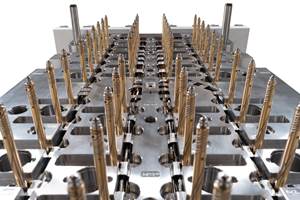Gradual Recovery Still Forecast
Total Mold Business Index for April 2010: 47.8
The Mold Business Index (MBI) for April 2010 is 47.8. This is a 3.1-point increase over the March value of 44.7, and it is an 8.2-point increase over the MBI value of 39.6 from April of last year. This is historically the time of year when the MBI data start to recover from a seasonal dip in the first quarter. The recent data indicate that the seasonal rate of decline in business activity for moldmakers this year was less steep than it has been in recent years. This month's data are consistent with our forecast of a gradual recovery in the mold industry during the second half of 2010. The bad news is that Mold Prices remain under pressure, and there is upward momentum building for Materials Prices. The industry's Future Expectations remain optimistic.
The overall U.S. economy has performed better than many forecasters anticipated so far in 2010, and the April data suggest that much of this momentum will be sustained during the second quarter. Real GDP posted a solid gain of 3.2 percent in the first quarter, with most of the growth coming from consumer spending. The trends in the corporate profits and the stock market data remain supportive for further economic growth this year.
As expected, new vehicle sales in the month of April declined a bit following Toyota's incentive-fueled surge in March, but the overall trend is still positive. By registering an annual rate of 11.2 million units last month, the auto sector is reflecting the slow, gradual improvement in consumer conditions that will persist through the end of this year. The ISM manufacturing index (a.k.a. the Purchasing Managers' Index) increased from 59.6 to 60.4 in April. This is the first time the index has been above 60 since 2004, and this forward-looking indicator is consistent with further gains in overall U.S. industrial production.
The New Orders component for our MBI declined for the seventh consecutive month in April, but the rate of decline is decelerating. This sub-index for April is 42.1. Despite the decline in new orders, production activity reportedly increased. The latest Production sub-index is a solid 60.5. The Employment component was 55.3 indicating that there was a small increase in overall payrolls last month. Fewer new orders combined with rising production levels resulted in a decrease in backlogs, as the Backlog component is 36.8 for April.
The Mold Prices sub-index for April is 44.7. This again indicates that the pressure from customers to lower the price of new molds remains intense, but this pressure may be easing up ever so gradually. The prices paid for materials continue to escalate, as the latest sub-index for Materials Prices is 68.4. Supplier Delivery Times were again slower, as this sub-index posted a value of 42.1. There was no change in the number of offshore orders for new molds, as the Export Orders sub-index is 50.0.
The most-cited problems confronting North American mold makers in recent weeks are low mold prices and getting paid on a timely basis for work completed. Other problems receiving multiple mentions were: customers not understanding the value of high-quality tooling; the sluggish economy; and the credit crunch.
Our Injection Molding Business Index (a measure of production levels for injection molders) increased in the first quarter of 2010 when compared with the previous year. This Index is expected to gain momentum gradually throughout 2010. The latest forecast calls for a gain of 7% this year. The total amount of injection molded goods produced was flat-to-slightly-higher in 2009 when compared with the previous year. Consistent gains in the Mold Business Index depend on sustained growth of 4 to 5 percent in the output of injection molded products. The trend in the mold making industry lags the trend in the processing sector by about six months.
The Mold Business Index is based on a monthly survey of North American moldmakers. Mountaintop Economics & Research, Inc. conducts the survey, and then calculates a diffusion index based on 50.0. A value above 50.0 for the MBI indicates that business activity expanded in the previous month, while a value below 50.0 means that business levels declined.
April 2010 | |||||
% Positive | % | % Negative | Net % Difference | Sub- Index | |
| New Orders | 37 | 10 | 53 | -16 | 42.1 |
| Production | 53 | 15 | 32 | 21 | 60.5 |
| Employment | 16 | 79 | 5 | 11 | 55.3 |
| Backlog | 26 | 21 | 53 | -27 | 36.8 |
| Export Orders | 0 | 100 | 0 | 0 | 50.0 |
| Supplier Deliveries | 5 | 74 | 21 | -16 | 42.1 |
| Materials Prices | 37 | 63 | 0 | 37 | 68.4 |
| Mold Prices | 5 | 79 | 16 | -11 | 44.7 |
| Future Expectations | 42 | 47 | 11 | 31 | 65.8 |
The total Mold Business Index is a weighted average of the sub-indices for new orders, production, employees, backlog, exports and supplier deliveries.
Related Content
VIDEO: Hot Runners and Sustainability
Oerlikon HRSflow North America Sales Director Robert Harvey breaks down hot runner technology that addresses sustainability opportunities and challenges.
Read MoreMMT CHATS: Navigating Challenges and Innovations in Large-Scale Mold Manufacturing
MSI Mold Builders shares how to overcome large-scale mold-building challenges, sustainability efforts and future technological advancements.
Read MoreHow to Solve Hot Runner Challenges When Molding with Bioresins
A review of the considerations and adaptations required to design hot runners and implement highly productive injection molding operations.
Read MoreAdvancing Moldmaking and Plastics: Trends in 3D Printing, Automation and Sustainability
NPE 2024 showcased the latest trends and technologies in innovation, efficiency and sustainability for moldmakers and molders, featuring advancements in 3D printing, automation, design and virtual reality/augmented reality/artificial intelligence.
Read MoreRead Next
Reasons to Use Fiber Lasers for Mold Cleaning
Fiber lasers offer a simplicity, speed, control and portability, minimizing mold cleaning risks.
Read MoreHow to Use Strategic Planning Tools, Data to Manage the Human Side of Business
Q&A with Marion Wells, MMT EAB member and founder of Human Asset Management.
Read MoreAre You a Moldmaker Considering 3D Printing? Consider the 3D Printing Workshop at NPE2024
Presentations will cover 3D printing for mold tooling, material innovation, product development, bridge production and full-scale, high-volume additive manufacturing.
Read More











.jpg;maxWidth=300;quality=90)










